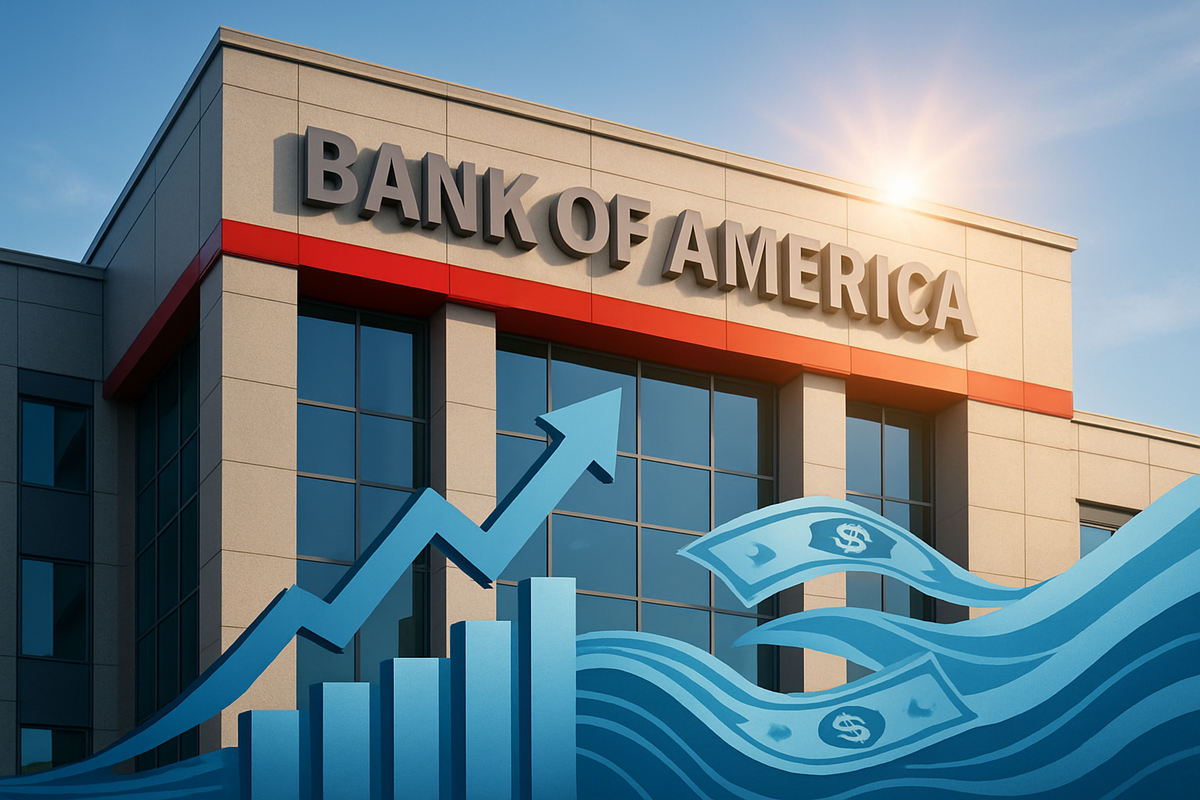
Bank of America Corporation (NYSE: BAC) has announced the authorization of regular cash dividends on several series of its preferred stocks for the fourth quarter of 2025. This declaration signals a robust financial position and a steadfast commitment to its preferred shareholders, reinforcing investor confidence in the institution's stability and ability to consistently meet its financial obligations. The move assures a predictable income stream for holders of these preferred shares, a demographic often seeking reliable returns and capital preservation.
The consistent declaration of preferred stock dividends is a strong indicator of a company's financial health and effective capital management. For Bank of America, a financial giant with a long history of shareholder returns, this action underscores its ongoing profitability and liquidity, even amidst evolving market conditions. It also highlights the bank's dedication to its capital structure, where preferred dividends hold a priority in payment over common stock dividends, making them a crucial aspect for risk-averse investors and institutional portfolios.
Detailed Coverage of the Event
The Board of Directors of Bank of America Corporation (NYSE: BAC) officially authorized the regular cash dividends for various series of its preferred stock for the fourth quarter of 2025 on October 17, 2025. This declaration encompasses a wide array of preferred share series, each with specific dividend amounts, record dates, and payment dates, ensuring a structured distribution of returns to its diverse preferred shareholder base.
Among the specific declarations, holders of the Floating Rate Non-Cumulative Preferred Stock, Series E, are set to receive a dividend of $0.30814 per share, with a record date of October 31, 2025, and payment scheduled for November 17, 2025. Similarly, the Floating Rate Non-Cumulative Preferred Stock, Series F, and the Adjustable Rate Non-Cumulative Preferred Stock, Series G, will each pay $1,187.90894 per share, with a record date of November 28, 2025, and a payment date of December 15, 2025. Other series, including various Floating Rate Non-Cumulative Preferred Stocks (Series 1, 2, 4, 5) and fixed-rate non-cumulative preferred stocks (Series GG, KK, LL, QQ, SS), also have their respective dividends declared, ranging from $0.2656250 to $0.3750000 per depositary share, with staggered record and payment dates throughout November and December 2025. It's noteworthy that most preferred stock series are represented by depositary shares, simplifying their trading and ownership.
This Q4 2025 dividend authorization follows a consistent pattern observed throughout the year, where the bank's Board of Directors typically approves such declarations in the month prior to or early in the quarter of scheduled payments. For example, similar declarations for payments in previous quarters occurred in September and April. The timing of this announcement also closely followed Bank of America's release of its robust Third Quarter 2025 Financial Results on October 15, 2025, which reported stronger-than-expected earnings per share and revenue. Furthermore, the bank recently announced the redemption of $2.5 billion of its 1.197% Fixed/Floating Rate Senior Notes due October 2026, on October 16, 2025, demonstrating proactive balance sheet management.
The initial market reaction to these events has been largely positive. Following the strong Q3 2025 earnings report, Bank of America's (NYSE: BAC) common stock experienced a notable surge, rising by 5.12% in pre-market trading to $52.19, nearing its 52-week high. The preferred stock dividend declaration, being a regular and anticipated event, served to further solidify investor confidence in the bank's continued financial stability and its unwavering commitment to returning capital to shareholders. This consistent track record, spanning 55 consecutive years of dividend payments, underscores Bank of America's reliability in the financial sector.
Companies That Might Win or Lose
The declaration of preferred stock dividends by a financial behemoth like Bank of America (NYSE: BAC) creates a nuanced landscape of winners and losers across various stakeholders, primarily driven by the strategic role preferred stock plays in a bank's capital structure and investor relations.
For Bank of America itself, the consistent declaration of preferred dividends is a significant win, serving multiple strategic purposes. Firstly, preferred stock enables the bank to raise substantial capital without diluting the voting power of its common shareholders, a critical aspect for maintaining corporate control. Secondly, these instruments are classified as Tier 1 capital, which is essential for meeting stringent regulatory capital adequacy ratios set by financial regulators. By issuing preferred shares, Bank of America strengthens its capital base, exemplified by its Common Equity Tier 1 (CET1) ratio comfortably above regulatory minimums, ensuring its ability to support liabilities and maintain stability. Furthermore, preferred dividends offer a degree of flexibility compared to debt interest, as payments can be deferred in severe stress without triggering a default, although missed non-cumulative preferred dividends are generally forfeited. This mechanism allows Bank of America to attract a specific, more risk-averse investor base seeking stable income, and can be a cost-effective way to acquire additional capital while optimizing its balance sheet without significantly increasing its debt-to-equity ratio.
The impact extends to other financial institutions and the broader banking sector. Bank of America's consistent preferred dividend payments reinforce market confidence in the stability and health of the financial system as a whole, especially given its status as a Global Systemically Important Bank (GSIB). Such declarations can set benchmarks for pricing and terms of similar instruments issued by other banks, influencing how they structure their own preferred stock offerings to attract capital. The resilience demonstrated by preferred shares of large, diversified banks like Bank of America during market volatility also signals a lower contagion risk across the sector, reinforcing perceptions of robust financial standing. Given that banks are the primary issuers of preferred stock, the regulatory environment for capital requirements directly impacts the demand and structure of these securities across the entire banking industry.
Among investors, the distinction between "winners" and "losers" is clear. The primary "winners" are income-focused investors and risk-averse investors who prioritize predictable, fixed income streams. Preferred stocks often offer higher yields than common stocks or bonds, and Bank of America's strong profitability ensures these dividends are well-covered. Institutional investors, particularly U.S. corporations, also benefit significantly from the "dividends received deduction," allowing them to deduct a substantial portion of preferred dividend income from their corporate taxes, making these shares highly tax-efficient. Furthermore, holders of floating-rate preferred stock, such as Bank of America's Series E, benefit in a rising interest rate environment as their dividend payments increase, often with a protective floor.
Conversely, "losers" typically include growth-oriented investors who seek capital appreciation, as preferred stock generally offers limited upside potential compared to common stock. Investors in fixed-rate preferred stock may see the market value of their holdings decline when interest rates rise, as their fixed dividends become less attractive relative to newer, higher-yielding investments. Holders of non-cumulative preferred stock face the risk of permanently losing missed dividend payments if Bank of America were to experience severe financial distress and suspend dividends. Common stockholders are inherently "losers" in terms of priority, as preferred shareholders have a higher claim on earnings and assets in the event of liquidation, and preferred dividends must be paid before any common stock dividends. Lastly, investors in callable preferred stock face reinvestment risk; if Bank of America calls its preferred shares, especially in a low-interest-rate environment, investors may be forced to reinvest their capital at a lower yield.
Wider Significance
Bank of America's (NYSE: BAC) Q4 2025 preferred stock dividend declaration, while a routine financial event, holds broader significance, offering a lens into the prevailing industry trends, the evolving regulatory landscape, and the strategic direction of major financial institutions. This consistent commitment to preferred shareholder returns underscores the bank's robust financial health within a dynamic global economy.
The declaration unfolds against a backdrop of an anticipated environment of falling, yet still elevated, interest rates. Projections suggest the Federal Reserve will continue with rate cuts in 2025, potentially settling the federal funds rate in the 3.5-3.75% range by year-end. For preferred stock, such an environment generally enhances its appeal. As new fixed-income issuances may offer lower yields, existing preferred stocks with their typically higher fixed dividend rates become more attractive to income-focused investors, solidifying their role as a stable component in investment portfolios. This trend can increase demand for Bank of America's preferred shares, benefiting the bank by maintaining a loyal investor base for its capital instruments.
The banking industry in late 2025 is also navigating a complex and evolving regulatory framework, with ongoing priorities focused on financial risk, capital adequacy, and overall resilience. Proposed adjustments to leverage capital standards, particularly for systemically important banks, could offer some flexibility in capital allocation, though the emphasis remains on maintaining strong capital buffers. The Federal Reserve's proposed amendments to the stress capital buffer (SCB) calculation, potentially by averaging stress test results, aim to reduce volatility and provide greater predictability. Bank of America's continued ability to declare preferred dividends demonstrates its strong compliance with these stringent capital frameworks and its capacity to manage regulatory expectations, reinforcing the effectiveness of post-crisis reforms.
Strategically, the banking sector is undergoing a profound digital transformation, driven by technological innovation and shifting customer expectations. Trends such as the rise of digital-only banks, the integration of Artificial Intelligence (AI) and automation, AI-driven personalization, and a shift towards customer-centric models are reshaping the competitive landscape. Bank of America, like its peers, is heavily investing in data analytics and AI to enhance customer experience, manage risk, and streamline operations. The stability reflected in its preferred dividend declaration indicates confidence in its ability to adapt to these strategic shifts, embrace embedded finance opportunities, and prioritize ESG considerations while maintaining financial stability and delivering shareholder value.
The ripple effects of Bank of America's stability are felt across the sector. A consistent preferred dividend from a major G-SIB like Bank of America sets a benchmark for other large banks regarding capital management and shareholder return expectations. This can exert pressure on competitors to demonstrate similar financial fortitude to attract and retain income-oriented investors. For partners, particularly fintech companies collaborating with Bank of America, the declaration serves as a positive indicator of the bank's long-term viability and robust financial health, potentially fostering continued and expanded partnerships.
Historically, the current robust state of preferred dividend payments stands in stark contrast to the 2008 financial crisis, when many banks, including Bank of America, suspended preferred dividends to conserve capital. The present situation highlights the significantly improved capital positions and enhanced regulatory oversight that have strengthened the banking sector since then. Post-Great Financial Crisis (GFC) regulations have ultimately benefited preferred shareholders by fostering greater stability in financial institutions. While common equity experienced severe impacts during the GFC, preferred stocks, especially those from large, diversified banks, demonstrated relative resilience, underscoring their hybrid nature as both equity and fixed-income instruments. The Q4 2025 declaration reaffirms this role in a stable environment and within an interest rate sensitive market.
What Comes Next
Bank of America's (NYSE: BAC) Q4 2025 preferred stock dividend declaration, following a robust Q3 2025 performance, sets the stage for a period of continued strategic focus and adaptation. Both short-term and long-term possibilities for the bank are shaped by its ongoing commitment to digital transformation, responsible growth, and sustainability amidst an evolving financial landscape.
In the short term, spanning Q4 2025 into 2026, Bank of America is expected to maintain its strong financial trajectory. The bank's impressive Q3 2025 results, including an Earnings Per Share (EPS) of $1.06 and a 10.8% year-over-year revenue increase, underscore its solid foundation. This performance was significantly boosted by a 43% year-over-year surge in investment banking fees and a record net interest income (NII) of $15.2 billion. The consistent preferred dividend declaration, alongside substantial share repurchases, signals continued financial stability and a firm adherence to its capital return policy. Analysts project continued earnings growth for Bank of America, with NII growth for 2026 anticipated in the range of 5-7%, driven by expected Federal Reserve rate cuts that could steepen the yield curve and enhance lending margins.
Looking further ahead, into 2027 and beyond, Bank of America's long-term vision is centered on building a sustainable, digitally empowered financial ecosystem. This involves significant investments, including $4 billion earmarked for AI and quantum computing initiatives in 2025, aimed at enhancing operational efficiency, client interactions, and expanding global reach through digital channels. The bank's commitment to ESG (Environmental, Social, and Governance) principles will also deepen, positioning it as a leader in responsible banking that blends financial innovation with ethical leadership and climate resilience.
To navigate the dynamic market, Bank of America will likely continue to implement several strategic adaptations. Foremost among these is an intensified focus on digital transformation and AI integration, aiming for 75 million active digital users by the end of 2025 through hyper-personalized services and automated operations. The bank will also prioritize deposit growth and client retention, especially for larger accounts, and optimize noninterest income strategies as NII dynamics shift. Sustainability and ESG leadership will remain critical, with a commitment to mobilizing $1 trillion in sustainable financing by 2030. Finally, agile risk management frameworks will be essential to adapt to geopolitical risks, evolving regulatory landscapes, and potential shifts in credit quality.
Market opportunities for Bank of America include a resurgence in investment banking activity, with forecasts of 13% growth in 2025, driven by M&A and issuance. Anticipated Fed rate cuts could lead to NII expansion and boosted loan growth. Enhanced digital adoption and hyper-personalization offer avenues for increased customer engagement and market share gains. The growing sustainable finance market presents significant leadership opportunities, alongside a global forecast of 6% loan growth in 2025.
However, significant challenges loom. Regulatory complexity continues to pose compliance hurdles and costs. Intense Fintech competition demands continuous innovation. Cybersecurity threats necessitate robust investment to protect data and trust. Economic uncertainty, geopolitical risks, and potential for a "non-soft landing" could lead to higher credit losses. Net interest margin compression due to persistent deposit costs in a lower-rate environment, ensuring data readiness for AI, and talent development in new skill areas are also critical challenges.
Considering these factors, several scenarios could unfold for Bank of America and its investors. In a baseline scenario of steady responsible growth, the bank continues its current trajectory, driven by digital adoption, modest NII expansion, and solid investment banking. Preferred shareholders enjoy consistent dividends, while common stock sees gradual appreciation. An optimistic scenario envisions accelerated digital innovation leading to significant market share gains and operational efficiencies, coupled with a stronger-than-anticipated economic recovery. This would result in strong common stock appreciation, increased dividends, and highly attractive preferred shares. Conversely, a challenging scenario involves a significant economic slowdown, increased loan defaults, and heightened regulatory headwinds. While Bank of America's strong capital position would likely safeguard preferred dividends, common stock profitability and dividends could face pressure, leading to market volatility and a shift towards lower-risk assets.
Comprehensive Wrap-up
Bank of America's (NYSE: BAC) declaration of regular preferred stock dividends for Q4 2025 is a powerful affirmation of its financial strength, prudent capital management, and unwavering commitment to its shareholders. This event, far from being a mere administrative formality, serves as a critical indicator of the bank's stability within a dynamic financial ecosystem. The detailed breakdown of dividend payments across various preferred series, coupled with the bank's robust Q3 2025 earnings and proactive balance sheet management, paints a picture of an institution well-equipped to navigate current and future market conditions.
The key takeaways from this declaration are manifold. It signals Bank of America's strong liquidity and profitability, its ability to meet fixed obligations, and its strategic use of preferred stock for capital raising without common stock dilution, while also fulfilling stringent regulatory capital requirements. The impact creates clear "winners" among income-focused, risk-averse, and institutional investors, particularly those holding floating-rate preferred shares. Simultaneously, it highlights the inherent risks for growth-oriented investors and common stockholders, who hold a subordinate position in the capital structure.
Moving forward, the market will assess Bank of America's ability to capitalize on opportunities such as a potential resurgence in investment banking, NII expansion from anticipated rate cuts, and accelerated digital adoption. The bank's significant investments in AI and its focus on a sustainable, customer-centric model position it for long-term growth. However, it must remain vigilant against challenges including regulatory complexities, intense competition from fintechs, cybersecurity threats, and broader economic uncertainties that could impact credit quality and net interest margins.
In conclusion, Bank of America's Q4 2025 preferred dividend declaration underscores its resilience and strategic foresight. It reinforces confidence not only in the bank itself but also in the broader financial sector's ability to maintain stability and deliver shareholder value. Investors should continue to watch for the Federal Reserve's interest rate decisions, Bank of America's ongoing digital transformation initiatives, its performance in managing credit quality, and any further regulatory developments. These factors will be crucial in shaping the bank's trajectory and the returns for its diverse investor base in the months and years to come.
This content is intended for informational purposes only and is not financial advice







